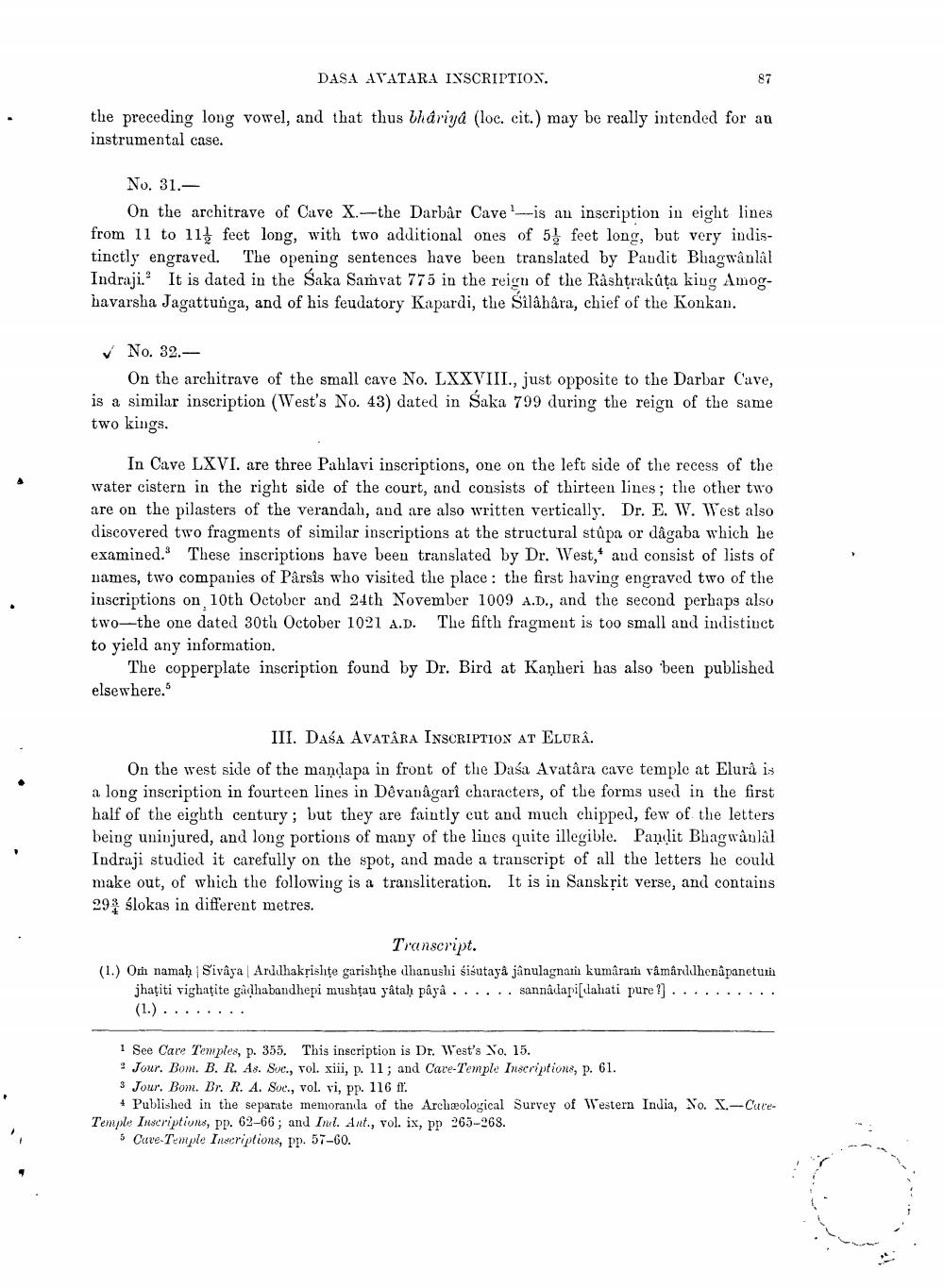________________
DASA AVATARA INSCRIPTION.
87
the preceding long vowel, and that thus driyd (loc. cit.) may be really intended for an instrumental case.
No. 31.
On the architrave of Cave X.-the Darbâr Cave is an inscription in eight lines from 11 to 11 feet long, with two additional ones of 5 feet long, but very indistinctly engraved. The opening sentences have been translated by Paudit Bhagwânlâl Indraji. It is dated in the Saka Samvat 775 in the reign of the Rashtrakuta king Amog havarsha Jagattunga, and of his feudatory Kapardi, the Silähâra, chief of the Konkan.
✔No. 32.
On the architrave of the small cave No. LXXVIII., just opposite to the Darbar Cave, is a similar inscription (West's No. 43) dated in Saka 799 during the reign of the same two kings.
In Cave LXVI. are three Pahlavi inscriptions, one on the left side of the recess of the water cistern in the right side of the court, and consists of thirteen lines; the other two are on the pilasters of the verandah, and are also written vertically. Dr. E. W. West also discovered two fragments of similar inscriptions at the structural stúpa or digaba which he examined. These inscriptions have been translated by Dr. West, and consist of lists of names, two companies of Pârsis who visited the place: the first having engraved two of the inscriptions on 10th October and 24th November 1009 A.D., and the second perhaps also two-the one dated 30th October 1021 A.D. The fifth fragment is too small and indistinct to yield any information.
The copperplate inscription found by Dr. Bird at Kanheri has also been published elsewhere.5
III. DASA AVATARA INSCRIPTION AT ELURA.
On the west side of the mandapa in front of the Dasa Avatâra cave temple at Elurâ is a long inscription in fourteen lines in Devanagart characters, of the forms used in the first half of the eighth century; but they are faintly cat and much chipped, few of the letters being uninjured, and long portions of many of the lines quite illegible. Pandit Bhagwanlal Indraji studied it carefully on the spot, and made a transcript of all the letters he could make out, of which the following is a transliteration. It is in Sanskrit verse, and contains 29 slokas in different metres.
Transcript.
(1.) Om namah Sivâya | Arddhakrishte garishthe dhanushi sisutaya jânulagnam kumaram vâmârddhena panetum jhatiti vighatite gadhabandhepi mushṭau yâtaḥ pâyâ.... (1.)....
sannâdapi[dahati pure?] . .
1 See Care Temples, p. 355. This inscription is Dr. West's No. 15.
Jour. Bom. B. R. As. Soc., vol. xiii, p. 11; and Cave-Temple Inscriptions, p. 61.
3 Jour. Bom. Br. R. A. Soc., vol. vi, pp. 116 ff.
+ Published in the separate memoranda of the Archæological Survey of Western India, No. X-CareTemple Inscriptions, pp. 62-66; and Ind. Ant., vol. ix, pp 265-268.
5 Cave Temple Inscriptions, pp. 57-60.




